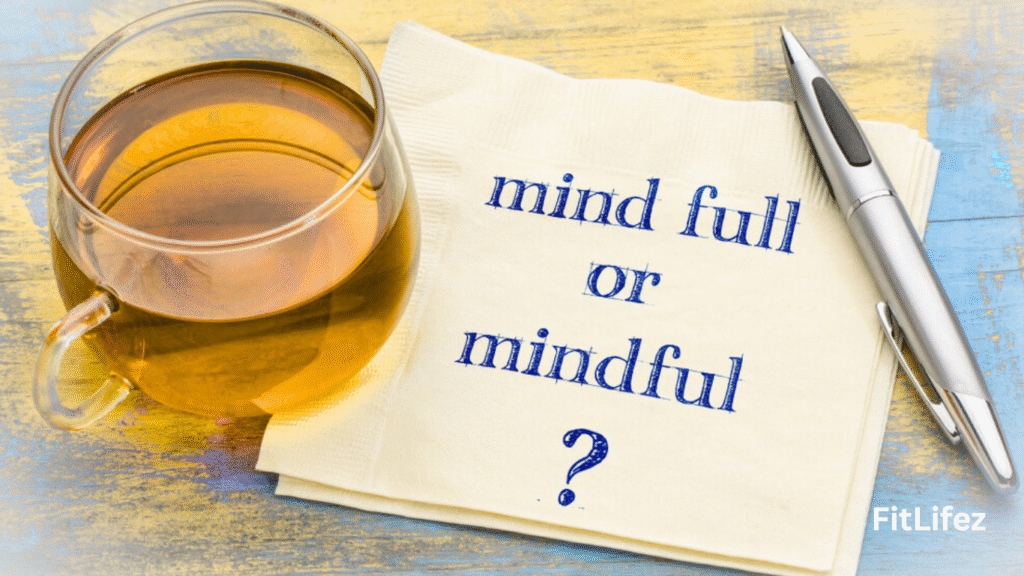Introduction
In today’s fast-paced world, our minds are often filled with thoughts about the past or worries about the future. We rarely pause to notice what is happening right now. Mindfulness is the practice of focusing on the present moment with full awareness and without judgment.
It is not just a meditation technique; it is a way of living that can be applied to everyday activities such as eating, walking, working, or even washing dishes. By practicing mindfulness in daily life, we can reduce stress, improve mental clarity, and enhance our overall quality of life.
The concept of mindfulness has its roots in ancient traditions, especially Buddhism, but modern science has shown that it is beneficial for people of all ages and lifestyles. Whether you are a student, a professional, or a homemaker, learning to live mindfully can help you feel calmer, more focused, and happier.
In this article, we will explore how to practice mindfulness in everyday life, the benefits of mindfulness, and some practical tips to make it a part of your routine.
1. What is Mindfulness?
Mindfulness means being fully aware of what you are doing, feeling, and thinking in the present moment. It is about paying attention deliberately and without judgment. For example, when you are eating, mindfulness means noticing the taste, texture, and aroma of the food rather than thinking about work or checking your phone.
Many people think mindfulness is about emptying the mind, but that’s a misconception. It is not about stopping your thoughts; it’s about observing them without getting carried away. You acknowledge your feelings—whether positive or negative—without labeling them as “good” or “bad.”
The key elements of mindfulness are:
- Awareness – Noticing your thoughts, emotions, and surroundings.
- Non-judgment – Accepting what is happening without criticism.
- Focus on the present – Not dwelling on the past or worrying about the future.
Mindfulness can be practiced through formal meditation or informal daily activities. Over time, it becomes a habit that transforms the way you experience life.
2. How to Practice Mindfulness in Everyday Life
You don’t need to set aside hours for mindfulness; you can incorporate it into your daily routine. Here are some simple ways:
a) Mindful Morning Routine
Start your day by paying attention to your first actions. Notice the feel of water on your skin while washing your face, the smell of your breakfast, and the sound of birds outside. Avoid rushing into your phone or email immediately.
b) Mindful Eating
When you eat, focus on each bite. Notice the flavors, chew slowly, and appreciate the nourishment. Avoid distractions like TV or mobile screens during meals.
c) Mindful Walking
While walking, pay attention to your steps, breathing, and surroundings. Feel the ground under your feet and notice the movement of your body.
d) Mindful Conversations
Give your full attention when someone speaks. Don’t plan your reply while they are talking; instead, listen deeply.
e) Mindful Breathing
Take a few moments several times a day to focus on your breath. Notice each inhale and exhale without trying to control it.
Practicing mindfulness in these small moments helps you stay grounded and reduces unnecessary stress.
3. Benefits of Mindfulness
The benefits of mindfulness are supported by scientific research. Here are some of the main advantages:
a) Reduces Stress
Mindfulness lowers the production of cortisol, the stress hormone. By focusing on the present, you avoid overthinking about the past or future, which reduces anxiety.
b) Improves Mental Clarity
When your mind is clear, decision-making becomes easier. Mindfulness helps you think logically instead of reacting emotionally.
c) Enhances Emotional Well-being
By observing your feelings without judgment, you develop emotional resilience. You learn to respond calmly instead of reacting impulsively.
d) Improves Relationships
Mindfulness promotes active listening, empathy, and patience, which strengthen personal and professional relationships.
e) Boosts Physical Health
Regular mindfulness practice can lower blood pressure, improve sleep quality, and strengthen the immune system.
4. Mindfulness and Work-Life Balance
Many people struggle to balance their personal and professional lives. Mindfulness can help you manage time, reduce burnout, and improve productivity. By staying focused on one task at a time, you avoid the exhaustion that comes with multitasking.
For example, when working, avoid switching between emails, phone calls, and projects. Instead, dedicate your full attention to one task before moving to the next. Similarly, when you are with family, put away work-related distractions and be fully present.
5. Common Challenges and How to Overcome Them
When you start practicing mindfulness, you may face challenges like:
- Restless mind – Your thoughts may wander frequently.
- Lack of time – You may feel too busy to pause and reflect.
- Impatience – Expecting quick results can lead to frustration.
To overcome these challenges:
- Start small—just a few minutes a day.
- Practice while doing routine activities like brushing teeth or cooking.
- Be patient; mindfulness is a skill that grows with practice.
6. Practical Tips to Make Mindfulness a Habit
- Set reminders on your phone to pause and breathe.
- Practice gratitude daily—write down 3 things you are thankful for.
- Create a mindful space in your home where you can relax without distractions.
- Use guided meditation apps to help you stay consistent.
1.Mindfulness in Everyday Life

Mindfulness is the practice of paying attention to the present moment with awareness and without judgment. In everyday life, this means being fully engaged in whatever you are doing—whether it’s drinking tea, working on a task, or walking outdoors—without letting your mind drift to the past or future.
This practice encourages you to notice sights, sounds, smells, and sensations as they occur. By integrating mindfulness into small daily activities, you create opportunities for calmness and mental clarity. For instance, mindful breathing during a busy day can help you stay centered, while mindful eating allows you to enjoy your food fully and avoid overeating.
Over time, these mindful habits can reduce feelings of stress and bring more peace into your life. Mindfulness also strengthens self-awareness, making you more attuned to your thoughts and emotions, which can lead to healthier responses in challenging situations.
2. Mental and Emotional Benefits of Mindfulness
One of the greatest advantages of mindfulness is its impact on mental health and emotional well-being. Practicing mindfulness can significantly reduce stress, anxiety, and negative thinking patterns. By focusing on the present, you break the cycle of overthinking and worrying about things you cannot control.
Mindfulness also enhances emotional regulation, helping you respond to situations more calmly and thoughtfully. This results in better relationships because you communicate with patience and understanding. At work, mindfulness improves focus and productivity by training your brain to stay on task.
Moreover, it nurtures empathy and compassion, both toward yourself and others, making you more tolerant and less reactive. These mental and emotional benefits not only improve your day-to-day life but also build long-term resilience, enabling you to cope with life’s ups and downs more effectively.
3. Physical Health Advantages of Mindfulness
Mindfulness is not just good for your mind—it also supports your physical health. Research shows that mindfulness practices can lower blood pressure, improve sleep quality, and strengthen the immune system. This is because mindfulness reduces the body’s stress response, lowering harmful cortisol levels that can contribute to various health issues.
For example, mindful eating improves digestion and helps in maintaining a healthy weight by encouraging you to eat slowly and recognize feelings of fullness. Mindful movement, such as yoga, tai chi, or walking meditation, can improve flexibility, balance, and muscle strength. Additionally, mindfulness supports heart health by promoting relaxation and reducing chronic stress.
These physical benefits, when combined with the mental improvements mindfulness brings, create a powerful foundation for overall well-being. Practicing mindfulness daily, even for just a few minutes, can lead to noticeable health improvements over time.
4. Mindfulness as a Path to Happiness and Fulfillment
Mindfulness plays a vital role in cultivating happiness and life satisfaction. When you live in the present moment, you become more aware of the small joys in life—a warm smile from a loved one, the beauty of nature, or the comfort of a quiet morning.
This awareness fosters gratitude, which is strongly linked to greater emotional health and contentment. Mindfulness also encourages self-acceptance, helping you let go of harsh self-criticism and embrace your authentic self. This shift in perspective builds self-confidence and a sense of inner peace.
Furthermore, mindfulness enhances resilience, allowing you to face challenges without feeling overwhelmed. In a world full of distractions, mindfulness acts as a mental anchor, keeping you focused, calm, and connected to what truly matters. Over time, this practice can transform your life into one that is more peaceful, productive, and deeply fulfilling.
5. Practical Ways to Practice Mindfulness Daily
Integrating mindfulness into your daily routine doesn’t require hours of meditation—it can be as simple as making small changes in your habits. One effective method is mindful breathing, where you focus on your breath for a few minutes, noticing the rise and fall of your chest and the feeling of air passing through your nose.
This simple act helps calm the mind and sharpen concentration. Another method is mindful walking, where you pay attention to each step, the sensation of your feet touching the ground, and the environment around you.
Mindful eating is also powerful; by slowing down, savoring flavors, and noticing textures, you enjoy your meals more and avoid overeating. Even daily chores, such as washing dishes or folding clothes, can become mindful practices if you pay attention to the sensations, movements, and smells involved. Over time, these habits make mindfulness a natural part of your life, allowing you to remain present and centered even during busy or stressful moments.
6. Overcoming Challenges in Mindfulness Practice
While mindfulness is beneficial, it’s not always easy to maintain, especially in today’s fast-paced, distraction-filled world. Common challenges include wandering thoughts, impatience, and the belief that you “don’t have time” for mindfulness.
It’s important to understand that mindfulness is not about completely silencing the mind but about noticing when your focus drifts and gently bringing it back to the present moment. Starting small—just one to two minutes of practice—can make it easier to develop consistency.
Another challenge is self-criticism, where people feel they are “failing” at mindfulness. In truth, there’s no perfect way to practice; every effort counts. Overcoming these challenges involves patience, self-compassion, and persistence. By making mindfulness a non-negotiable part of your day, you gradually strengthen your ability to remain present, even when life feels overwhelming.
7. Long-Term Impact of Mindfulness on Life Quality
Practicing mindfulness regularly has a profound long-term effect on the quality of life. Over months and years, it reshapes the brain, strengthening areas related to focus, emotional regulation, and compassion. People who stick with mindfulness often report a deeper sense of purpose and clarity about their goals.
They experience less burnout and recover from stress more quickly. Mindfulness also improves relationships by enhancing communication skills and reducing unnecessary conflicts. On a personal level, it fosters self-awareness, helping you make healthier decisions about your career, health, and personal growth.
Over time, mindfulness becomes more than just a practice—it becomes a way of living, allowing you to approach life’s challenges with calm confidence and to fully enjoy its moments of joy and beauty. This transformation can lead to a life that feels more balanced, meaningful, and deeply satisfying.
Conclusion
Mindfulness in everyday life is more than a trend; it’s a powerful way to improve mental, emotional, and physical well-being. By focusing on the present moment and letting go of unnecessary worries, you can live a calmer, happier, and more fulfilling life.
Start small—be mindful while brushing your teeth, eating breakfast, or walking to work. Over time, these small changes can transform your mindset, reduce stress, and help you enjoy life more fully.

